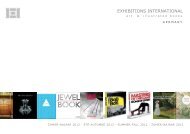Famille Verte - exhibitions international
Famille Verte - exhibitions international
Famille Verte - exhibitions international
Create successful ePaper yourself
Turn your PDF publications into a flip-book with our unique Google optimized e-Paper software.
107 - Lantern<br />
China, first quarter of the 18th century<br />
H. 16.8 cm, D. lantern 16 cm, D. base 16.9 cm<br />
Rijksmuseum Amsterdam, inv. no. AK-RBK 15867<br />
Formerly in the collection of R. May. Acquired by the State in 1944, transferred to the<br />
Rijksmuseum in 1946<br />
Hexagonal lantern or nightlight, the underside open, on a<br />
separate flat base with a moulded plinth. The sides and flat<br />
top pierced with vertical cartouches containing a roundel and<br />
a swastika motif. Decorated in famille verte enamels on the<br />
biscuit with flowers and dragons on a speckled ground, on top six<br />
butterflies and flowers on a similar ground.<br />
This lantern held a candle or oil lamp, the light of which shone<br />
through the openings. Liang Yu describes a comparable lantern<br />
as a ‘flower perfumer’, probably because scented oil was used.<br />
According to Eberhard (refs.), the swastika is a very old form of<br />
the character fang, meaning ‘the four regions of the world’. It has<br />
become an emblem of immortality and infinity and is often used<br />
as a decorative motif. The museum has a comparable, square<br />
lantern (inv. no. RBK 15868). A closely related lantern is in the<br />
Palace Museum, Beijing (ref. Li Zhiyan).<br />
Publ.: Lunsingh Scheurleer 1972, pl. 129; Lunsingh Scheurleer<br />
1985, no. 83; Jörg & Van Campen 1997, cat. 212<br />
Refs.: Honey 1927, pl. 57a; Hobson 1925/1928, vol. 5,<br />
pl. XXVII-E139; Eberhard 1986, pp. 280–81; Beijing 1989,<br />
p. 117, no. 100; Li Zhiyan 2010, p. 484<br />
120<br />
108 - Guanyin<br />
China, early 18th century<br />
H. 28.3 cm, base 20.5 x 9.2 cm<br />
Rijksmuseum Amsterdam, inv. no. AK-NM 12467<br />
Acquired from Gorer, art dealers, London, 1919, with the aid of the Rembrandt Society<br />
Figure of Guanyin on a tall, moulded plinth, the front with<br />
a pierced motif. The goddess, set against a semicircular<br />
background of tall pierced rocks, is seated on a lotus flower<br />
rising from the water, as indicated by curling waves. The head<br />
and tail of a carp emerges from the water, a vase on a rock in<br />
the middle. Acolytes on either side of Guanyin, one standing on<br />
a lotus leaf, the other on a flower growing from the same plant.<br />
Guanyin has a mandorla around her head, with bamboo growing<br />
above it. Covered with aubergine, green and yellow enamels on<br />
the biscuit. The museum has a similar, slightly smaller example<br />
(inv. no. MAK 573).<br />
This figure may have been made for a house altar, but it is also<br />
possible that it was produced as part of the assortment of exotic<br />
figures and groups for export to the West. The iconography of<br />
Guanyin seated on a lotus is related to the representations of<br />
the Bodhisattva Avalokiteshvara as Padmapani, ‘Lotus Hand’,<br />
where he is shown with a lotus (padma) in one hand. Figures<br />
of Guanyin in a cave often show her with two acolytes, namely<br />
Shancai (‘Excelling in Riches’), a boy with folded hands; and<br />
Longnu (‘Dragon Daughter’), a girl with a jewel or a peach on<br />
a cushion (ref. Stein). The three-dimensional composition and<br />
the finely moulded details make this an exceptional piece within<br />
its category.<br />
Publ.: Jörg & Van Campen 1997, cat. 204<br />
Refs.: Lim 1978, no. 52; Stein 1986, p. 18


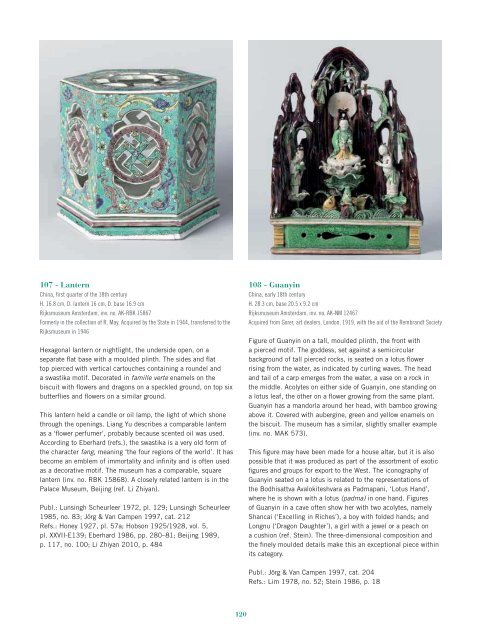
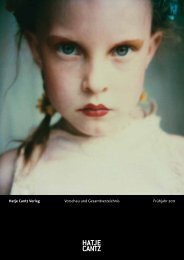
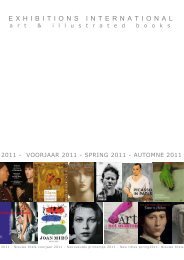

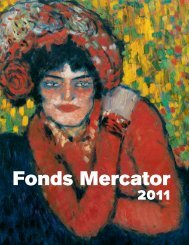
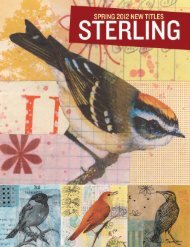
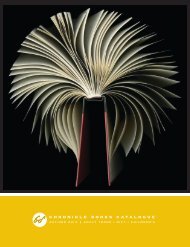
![01 -[BE/INT-2] 2 KOL +UITGEV+ - exhibitions international](https://img.yumpu.com/19621858/1/184x260/01-be-int-2-2-kol-uitgev-exhibitions-international.jpg?quality=85)





